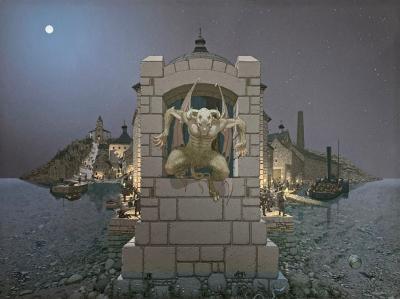Demon Drink
Published: 2 May 2022
New exhibition explores the theme of alcohol in art and the contradiction of the positive and negative consequences of the ‘demon drink’.
20 May–18 September 2022
Hunterian Art Gallery
Admission free
A fascinating new Hunterian exhibition explores the theme of alcohol in art and the contradiction of the positive and negative consequences of the ‘demon drink’.
 Opening at the University of Glasgow’s Hunterian Art Gallery on 20 May, Demon Drink blends items from The Hunterian collections with the artwork of internationally renowned graphic artist Frank Quitely.
Opening at the University of Glasgow’s Hunterian Art Gallery on 20 May, Demon Drink blends items from The Hunterian collections with the artwork of internationally renowned graphic artist Frank Quitely.
Demon Drink examines themes including the consumption of alcohol, the Temperance Movement, indulgence and the overlap between high art, popular culture and marketing. It also explores the process of making art and how this can be applied to a context, be it commercial, social or religious.
The one-room exhibition connects works made at different periods in time and for very different purposes, ranging from Renaissance prints such as Venus, Bacchus and Ceres by Hendrik Goltzius (1595) which shows drink as a convivial aphrodisiac, to raucous everyday scenes like The Drunken Couple by Cornelis Dusart (1685) and William Hogarth’s moralising Gin Lane (1751).
As well as these historical depictions, Demon Drink also features stunning new artwork of the Devil on Islay, created for Bowmore whisky by Glasgow-based comic artist Frank Quitely. The exhibition presents this popular art form in a ‘high art’ setting and also features an overview of Quitely’s process of creation.
Other highlights include Glasgow. Scotland. 1980. by acclaimed photographer Raymond Depardon, 19th and 20th century Temperance Society medals, a teacup from Miss Cranston’s tearooms in Glasgow and a silver flask owned by the American artist James McNeill Whistler.
Demon Drink is at the Hunterian Art Gallery from 20 May–18 September 2022. Open 10am–5pm, Tuesday–Sunday. Admission free.
Hunterian Art Gallery
University of Glasgow
82 Hillhead Street
Glasgow G12 8QQ
Image: Frank Quitely, No Corners to Hide, 2022. Courtesy of the artist and Bowmore.
For further information contact:
Joseph Sharples, Curator (Mackintosh Collections and Applied Art), The Hunterian
Joseph.Sharples@glasgow.ac.uk
Professor Laurence Grove, Professor of French and Text/Image Studies, University of Glasgow
Laurence.Grove@glasgow.ac.uk
For images contact:
Harriet Gaston, Communications Manager, The Hunterian
Harriet.Gaston@glasgow.ac.uk
Notes to Editors
The Hunterian
The oldest public museum in Scotland, with collections spanning arts, sciences and humanities, The Hunterian is at the forefront of university museums around the world. Since it opened at the University of Glasgow in 1807, The Hunterian has been an invaluable academic and community resource and in years to come, The Hunterian is committed to becoming a more meaningful place for more diverse audiences.
As a university gallery and museum The Hunterian creates space for intellectual inquiry and a process of learning and experimentation. The Hunterian collection’s Enlightenment history made a repository of knowledge that materialises the problematic history of Western modernity and its fundamentally colonial and capitalist underpinnings. The founding collection came through the bequest of Dr William Hunter (1718-1783) and since The Hunterian opened at the University of Glasgow in 1807, the collections have been developed in ways that reflect our city’s deep relationship with empire, transatlantic slavery, colonialism and migration.
The Hunterian cares for some Scotland’s finest collections that cover subjects as diverse as the history of medicine, zoology and art. The whole collection is ‘Recognised’ as nationally significant in Scotland and includes outstanding Roman artefacts from the Antonine Wall; vast natural and life science collections; scientific instruments used by James Watt, Joseph Lister and Lord Kelvin; one of the world’s greatest collections of coins and medals and objects and belongings brought to Glasgow from around the world during hundreds of years of trade, empire, exploitation and migration.
The Hunterian is also home to one of the most distinguished public art collections in Scotland and features works by James McNeill Whistler, the Glasgow Boys and Scottish Colourists, the largest single holding of the work of artists Margaret MacDonald and Charles Rennie Mackintosh, along with The Mackintosh House, the reassembled interiors from their Glasgow home. The Hunterian has also developed an important collection of works by leading contemporary artists including Christine Borland, Lucy Skaer and Adam Pendleton.
glasgow.ac.uk/hunterian
Twitter @hunterian
Facebook @HunterianGlasgow
Instagram hunterianglasgow
First published: 2 May 2022

